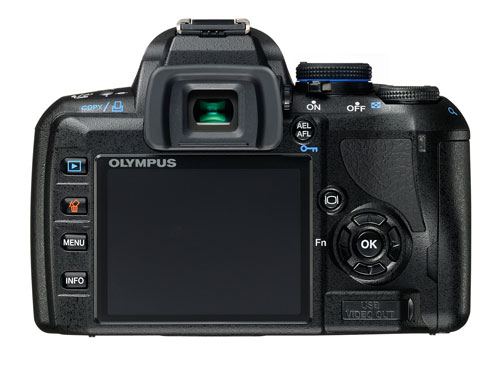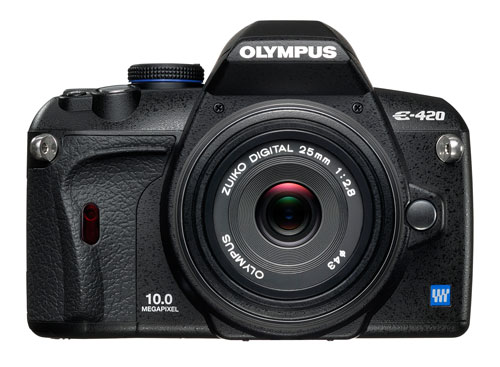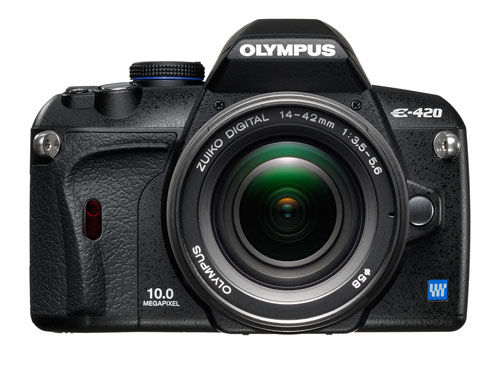A Closer Look
The baby Olympus DSLR weighs just 380 grams (13.4 ounces), and measures just 5.1" by 3.6" by 2.1". This is 20 to 40 percent smaller than competing DSLRs. Olympus did not include in-camera image stabilization, presumably to keep down cost and weight. Instead, "Digital Image Stabilization" is available as a Scene Select. Digital Stabilization was first introduced on the E-330 and also featured on the current E-410. This is a program that favors high ISO sensitivity and faster shutter speeds for greater possibilities of capturing sharp, blur-free images. 18 scene modes cover the gamut of shooting situations on the E-420.
The autofocus system in the E-420 appears to be the same 3-point system used in the E-410 and E-510. That is probably OK for the entry-level market in which the E-420 competes. The new Nikon D60 also uses a basic 3-point AF system. However, we had hoped some of the breakthrough AF technology used in the E-3 would find its way into lower models. Perhaps we will see that in future Olympus models such as the one that will eventually replace the current E-510. The E-420 also does not support an accessory battery grip, which for some will be a shortcoming the E-420 shares with the new Nikon D60. The upcoming entry-level Canon XSi does support an accessory battery grip, but its announced street price is much higher than the E-420.

The trademark Olympus Supersonic Wave Filter automatic dust reduction system is also featured on the new camera. Every digital SLR produced by Olympus since the first E-1 appeared in 2003 has featured auto sensor cleaning. The E-420 supports wireless multi-flash with the FL-36R and FL-50R, which were recently introduced with the E-3. Olympus says the E-420 also features improved Auto White Balance, faster image processing, and lower noise with the updated TruePic III processor. Continuous shooting speed goes up to 3.5fps, which is fast compared to other entry-level cameras.
The E-420 is expected to ship in early May in several kit choices. We do not yet have the camera for testing, but Olympus has promised us a sample as soon as the E-420 is available. Estimated street prices are as follows:
- E-420 body : $499.99
- E-420 with ED 14-42mm f3.5/5.6 Zuiko Digital Zoom Lens: $599.99
- E-420 with ED 25mm f2.8 Zuiko Digital Lens: $699.99













16 Comments
View All Comments
Wesley Fink - Thursday, March 6, 2008 - link
The Olympus auto sensor cleaning is regarded by most as the most effective available in DSLR cameras, so dust is hardly a concern. I do not understand your lens point since the 14-42 (28-84), 40-150 (80-300), and 35 (70) macro are all three the smallest and lightest lenses in their class, and optically quite excellent. Now there will also be a tiny 25mm (50) pancake lens as a kit choice.I do agree the E-420 would be better with body integral IS and an updated AF system with more points, but it is certainly competitive at its selling price. The E-420 is not a camera for everyone, but for those who really want a tiny DSLR camera and system it is one of the few options available.
haplo602 - Sunday, March 9, 2008 - link
well it's good to know that the Oly sensor cleaning is one of the best, but a closed P&S system does have NO dust worries, so no reason to pay for the extra parts.as to the lenses, yes they might be small and good, but you still need to carry them and change them as needed. this kind of defies the minimal size and weight of this SLR. P&S has the same size and weight minus the lens hassle (ofc it is limited to only one lens).
and to reply to the poster about the sensor size. I do not think the 4/3 sensor size is that much a win if you are climbing 10+MP.
Samus - Thursday, March 6, 2008 - link
This camera, like the Celeron 420, daftly targets the 4:20 crowd ^_^Johnmcl7 - Wednesday, March 5, 2008 - link
It was actually the E-330 which has the dubious honour of being the first Olympus SLR with the digital image stabilisation scene mode. Also it's worth bearing in mind that the E-400 and E-410 are actually more different than they perhaps seem, the E-400 was a bit of a 'test' camera only released to Europe with a Kodak 10MP CCD sensor, no liveview and some other missing features such as no mirror lockup. The E-410 uses a Panasonic 'NMOS' sensor, has liveview, mirror lockup and some other small touches. Irritatingly all the E-4xx cameras lack the ISO/EXP/WB/AF selection on the rear d-pad which their E-5xx siblings have.Pleased to see Olympus produce a 25mm pancake lens as there's no doubt that there's a market for small and light DSLRs. Hopefully if this does well we'll see some more pancake lenses as 14mm is the one I'm wanting. While I like the E-3 I definintely think there's a market for a pro-spec body around the size of the E-4xx - while there'd need to be some compromises it would appeal as a second camera for other system owners (particularly 35mm Nikon/Canons) rather than trying to take market away as they have tried with the E-3.
John
Wesley Fink - Wednesday, March 5, 2008 - link
I did not realize the E-330 pioneered the Digital Image stabilization feature. As you allude the in-body mechanical IS would have been a more desirable choice IMHO. I have corrected the reference.pervisanathema - Wednesday, March 5, 2008 - link
IB camera snobs